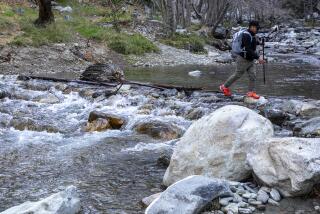More Areas of Forest to Be Closed
- Share via
Federal authorities today will announce plans to close vast stretches of the San Bernardino National Forest, the second time in a week that severe fire and drought conditions have forced officials to shut down public wilderness in Southern California.
Mike Dietrich, the U.S. Forest Service fire chief in the San Bernardino forest, said Tuesday evening that the closures will go into effect at noon Friday and could last a month or more. Parts of the 671,686-acre national forest were last closed in 1999; the entire forest was shut down in 1972, Dietrich said.
Forestry officials are also considering similar closures in the Cleveland National Forest north of the Mexican border and east of San Diego, authorities confirmed, though decisions there are not expected until next week.
Dietrich said the action in the San Bernardino will be less severe than the broad closure implemented in the neighboring Angeles National Forest last week, though details were still being worked out late Tuesday.
Several popular tourism spots in the San Bernardino forest, such as the Big Bear Discovery Center, will remain open because the threat of fire is low and firetrucks have easy access on good roads, he said. And some developed, permanent sites in the forest, including Boy Scout camps, will remain open. Residents will continue to have access to their homes.
But the vast majority of the forest, which begins at the eastern border of the Angeles National Forest and folds in the communities surrounding Big Bear, Lake Arrowhead and the San Gorgonio Pass before spilling into the desert, will be closed, he said.
Hiking, horseback riding and off-road vehicle use will be prohibited, Dietrich said. Campfires have already been banned in the entire park. Towns will remain open.
The San Bernardino National Forest is one of the most popular recreational spots in the state, said Forest Service spokesman Matt Mathes, and is visited by more than 10 million people each year.
“We do not like to close the forest to public use unless conditions are extreme,” Dietrich said. “We are stepping up to the plate and taking the appropriate action because of fire danger.”
In Idyllwild, high above the San Gorgonio Pass, Atipahato Lodge owner Frank Gaynor said the closure will be difficult for businesses, from art galleries to restaurants, that rely in part on recreational visitors. But, he said, the closure “seems to make some sense under the current conditions. The last thing we need is a fire on top of the drought.”
News of the closure drew similarly mixed reactions at Lake Arrowhead resort, where the lake is at historic lows with 500 docks sitting on dirt.
Richard Teacher, owner of the 10-room Storybook Inn bordering national forest land, said, “Not to be able to stroll through the forest will be a sad thing for our guests.
“But it’s the right thing to do,” he added. “We have so many dead trees that bark beetles ravaged because of the drought that the fire danger is very high.”
On Sept. 24, as the so-called Williams fire was churning through more than 35,000 acres above the San Gabriel and Pomona valleys, the Forest Service decided to close the Angeles forest for the first time since 1993.
It remained off-limits to hikers, mountain bikers, campers and others Wednesday, and main roads within its boundaries, including Angeles Forest and Angeles Crest highways, were open for through traffic only.
There were no significant, active fires in the San Bernardino forest Tuesday.
A moisture-laden weather system that hovered off the coast for much of the last week helped firefighters wrestle the Williams fire into submission, and gloomy weather over much of Southern California seemed to suggest that the threat of wildfires had faded with the end of summer.
To the contrary, Dietrich said. The weather provided what forestry officials believe is a brief respite.
This weekend, a high-pressure system is expected to arrive, driving temperatures in some areas back into the 90s, officials said, and possibly creating dangerous Santa Ana wind conditions that could cause wildfires to spread quickly.
Even without those winds, Dietrich said, the Forest Service expects that it will be “right back in the same ballpark” because of the weather. “There was a little bit of a breather,” Dietrich said. “But the amount of precipitation we had was inconsequential to the overall conditions. The conditions we are in don’t change overnight.”
Mathes said federal officials are especially wary of fire conditions in the San Bernardino because it is one of half a dozen national forests that abut major urban areas. Most national forests, such as those in Idaho and Wyoming, are in remote areas.
Officials have said they do not plan to reopen the Angeles until there is rainfall sufficient to mark the end of fire season.
*
Times staff writers Louis Sahagun and Jean Merl contributed to this report.
More to Read
Sign up for Essential California
The most important California stories and recommendations in your inbox every morning.
You may occasionally receive promotional content from the Los Angeles Times.











